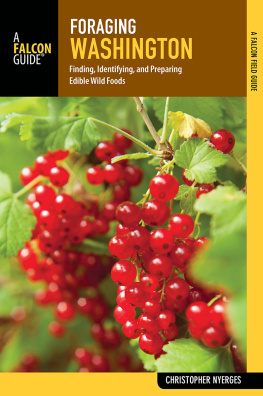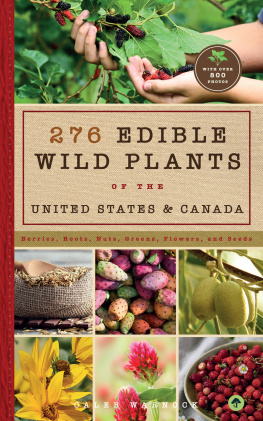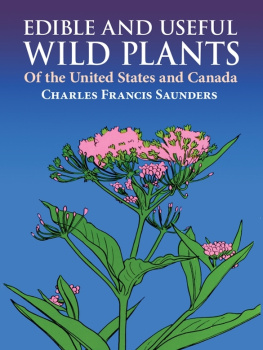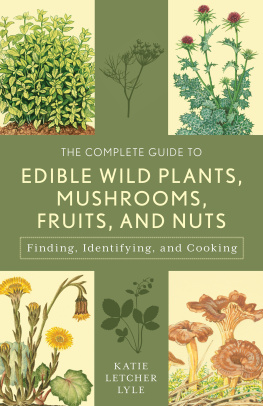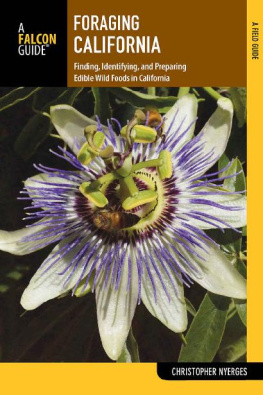ABOUT THE AUTHOR
Christopher Nyerges, cofounder of the School of Self-reliance, has led wild food walks for thousands of students since 1974. He has authored ten books on wild foods, survival, and self-reliance, and thousands of newspaper and magazine articles. He continues to teach and lecture about wild foods and self-reliance issues. He and his wife, Helen, live in Los Angeles County, California.
ACKNOWLEDGMENTS
As usual, a book is not the product of one person. Lots of bright folks helped me with this project. Paul Campbell made lots of useful suggestions during the inception of this book, and offered lots of tips and hints for what to include. Dr. James Adams read the text, offered suggestions, and wrote the foreword. Dr. James Bauml read the HIPs section for accuracy and made good suggestions. Mickey Long assisted me with the environmental section. And this project couldnt have been completed without the assistance of the photographers who participated. These include Zoya Akulova, Aaron Arthur, Daniel Baird, Pascal Baudar, Debra Cook, John Doyen, Trent Draper, Julie Kierstead Nelson, Jean Pawek, Vernon Smith, Helen Sweaney, and especially Rick Adams.
Nuts
ACORN
Quercus spp. and Notholithocarpus densiflorus
Description: Acorns are the nuts of the oak tree. Each acorn has a scaly cap. Depending on the species of oak tree, each acorn is a bit different, and yet every child can recognize an acorn! Oak trees can be deciduous or evergreen, with some being bushes, though most are very large trees.
Uses: Acorns are leached of tannic acid and used to make pastry products.
Habitats: Oak trees are found widely in urban areas, in the chaparral, in the mountains, in the Central Valley. Their collective habitat is broad.
Range: There are 25 species of oak in the state, and they are widespread.
Tools: A bag or bucket is needed for collecting acorns. You need a hand stone to crack them open, and grinders and colanders, depending on how youll be processing the acorns.
Acorns are produced by trees in the Oak family (Fagaceae). Worldwide, this family includes seven genera and about 900 species. There are three genera in California, and Quercus is the most widespread. There are twenty-five species of Quercus in California, not including the subspecies. Also included in this category is the tanbark oak or tanoak (Notholithocarpus densiflorus). This tree was once called Quercus densiflora, but has been reclassified into a different genus because of a few key differences. To the average person looking at the tanbark oak, its very much an oak whose acorn caps appear shaggy. Otherwise, the tanoaks acorn is used just like any other acorn. Notholithocarpus is one of the three genera of the Oak family in California, and the tanbark oak is the only species (with two varieties) of this genus. (The third genus of this family found in California is the chinquapin, which we deal with separately.)
Oak trees are everywhere in California, found in most environments. Most are large trees, but some are bushlike, such as the scrub oak. Some are evergreen (the live oaks), and some are deciduous, such as the black oak and valley oak. Oaks are inherently beautiful, and they convey a sense of the essence of what California is. They are perhaps the quintessential California tree, the source of food and survival for the indigenous peoples who lived here for millennia before the European invasion. The oaks very image expresses the stereotypical California landscape.
In the fall of most years, acorns drop from the trees, often in great numbers. Some years are better than others.
Acorns were so important to the indigenous California population that they could be regarded as the breadbasket in the pre-Spanish days. Nearly every California tribe used acorns. Acorns would be collected and stored, and then processed as needed. Acorns generally fall from the trees beginning in late September, and can still fall into January. It is best to collect the acorns off the ground so you know they are mature.
If you dont have the time to shell the acorns right away, you should dry them so they do not get moldy, and so that larvae does not develop. Lay them on cookie sheets in the full sun for a few days, or place them in an oven where a pilot light will help to dry them. When youre ready to begin cooking with acorns, your first step will be to shell them. If your acorns are dry, you can place each acorn on a flat rock, and hit it with another rock, and the shell will come off easily. You can try whatever works for youa rock, a hammer, a piece of wood.
Then the acorns must be processed to remove the tannic acid, and there are several ways you can do this.
Lets look at the expedient way to process acorns first. Shell the acorns and put them into a pot. Cover with water and bring to a boil. Within a few minutes the water will look like mud, as the tannic acid comes out of the acorns. Dump the water and add fresh water. Bring to a boil again. Rinse, and do it again. How long do you do this? Since each variety of acorn has a different amount of tannic acid, you must periodically taste one of the acorns. Still bitter? OK, do another boiling. When you taste the acorn and its just bland, with no bitterness, it should be done.
BARBARAS ACORN POUND CAKE
Mix together the following:
cup olive oil
cup sugar or cup honey
2 eggs
cup acorn flour
Next, mix together the following:
1 cups whole wheat flour
teaspoon salt
teaspoon cream of tartar
teaspoon baking soda
Stir the second mixture into the first, a little at a time, alternating with the following:
cup milk
teaspoon vanilla extract
teaspoon mace or teaspoon nutmeg
Beat the mixture all well. Pour into an oiled 8-inch square or round pan, or a bread pan. Bake at 350 degrees for 50 to 60 minutes.
When the acorns are leached, you could actually just toss them in a pot with vegetables and seasonings, and make a stew. Or, if youre out camping, you might mash up the leached acorns on a rock, and use the mush as a thickener for a soup or stew.
If youre at home and you try this method, you could also run the acorns through a meat grinder to reduce them to a coarse meal, and then process them into a finer meal, as needed.
You could also try processing the acorns using a method that is more akin to the way it was done by the indigenous peoples of California, the method that I prefer.
First the acorns are shelled, and then I grind them on a flat metate, as was done in the old days. Next, I line a colander with a piece of cotton, and put in the ground acorn meal. I then pour cold water through the acorn meal, and let it filter through the cotton, taking the tannic acid out with it. It will likely take several pourings to get out all the bitterness.
The time required to leach the acorns is partly a factor of how bitter the acorns are in the first place, which is determined by species. Its also a factor of what sort of cotton you use for the filter. Dont use a tight-weave cotton fabric, like a pillowcase, since it will take too long for the water to filter through. You should use something like a cotton kerchief.
I like to make pancakes, biscuits, or cookies with acorns. For pancakes or biscuits, I use 50 percent acorn flour to 50 percent whole wheat or mixed grain flour. I add more water to the pancake batter, and less to the biscuit mix. For cookies, I use the same blend, often adding raisins or peanut butter.




